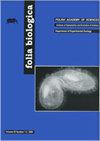在一个严重改变的河流系统中为水甲虫(昆虫纲:鞘翅目)寻找合适的栖息地
IF 0.8
4区 生物学
Q4 BIOLOGY
引用次数: 0
摘要
奥德拉河是一条受到管制的大河,沿河修建了许多石窟。很少有出版物研究河滩如何影响河流的功能。研究了在人类压力较大的河流中,水利工程对水甲虫区系的影响。并与奥德拉河谷地区的牛甲进行了比较,比较了其种类组成、组合、功能和生态类群。研究表明,河滩田对水甲虫的生长非常有利,为牛甲虫提供了非常合适的替代栖息地,牛甲虫虽然是天然的,但却是河谷中敏感的濒危栖息地。在洼地的数量优势种是嗜流菌,它们是典型的弱富营养化、良好氧合的牛弓。就种类而言,泛型是最重要的甲虫组合。大型植物和有机质是控制腐生体和多噬体发生的因素,为这些生境的优势捕食者提供了丰富的食物资源。两种生境类型的pH值、可见度、温度、硬度和O2以及植被、水深和沿岸宽度都是甲虫分布的关键。山沟田的存在使得奥德拉河水甲虫的物种丰富程度可以与大型天然河流相媲美,这充分表明并非所有人为的栖息地变化都是负面的。本文章由计算机程序翻译,如有差异,请以英文原文为准。
In search of suitable habitats for water beetles (Insecta: Coleoptera) within a heavily transformed river system
The Odra is a large, regulated river, along which many groynes have been built. There are few publications examining how groynes affect the functioning of a river. We investigated the effect of these hydro-engineering structures on the water beetle fauna of a river subject to strong
human pressure. The species composition, assemblages, functional and ecological groups of these beetles in groyne fields were compared with those of oxbows in the Odra valley. We demonstrated that the groyne fields were highly beneficial for water beetle development, offering highly suitable
alternative habitats to oxbows which, though natural, are sensitive and endangered habitats in river valleys. The numerically dominant species in the groyne fields were rheophiles, which are typical of weakly eutrophic, well-oxygenated oxbows. Species-wise, eurytopes were the most important
beetle assemblage. Macrophytes and organic matter were the factors governing the occurrence of saprophages and polyphages, which provide plentiful food resources for the predominating predators in these habitats. Either the pH, visibility, temperature, hardness and O2 both the vegetation,
water depth, breadth of the littoral of the two habitat types were key to the beetles' distribution. The presence of groyne fields has rendered the species richness of the Odra's water beetles comparable with that of large, natural rivers, which amply demonstrates that not all anthropogenic
transformations of habitats are inherently negative.
求助全文
通过发布文献求助,成功后即可免费获取论文全文。
去求助
来源期刊

Folia Biologica-Krakow
医学-生物学
CiteScore
1.10
自引率
14.30%
发文量
15
审稿时长
>12 weeks
期刊介绍:
Folia Biologica (Kraków) is an international online open access journal accepting original scientific articles on various aspects of zoology: phylogeny, genetics, chromosomal studies, ecology, biogeography, experimental zoology and ultrastructural studies. The language of publication is English, articles are assembled in four issues per year.
 求助内容:
求助内容: 应助结果提醒方式:
应助结果提醒方式:


